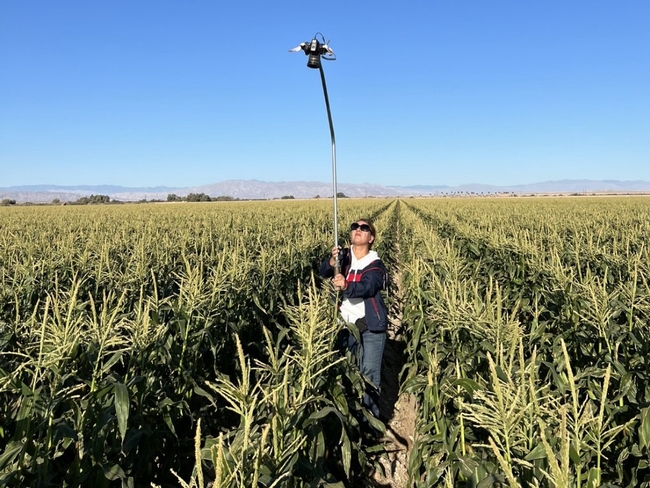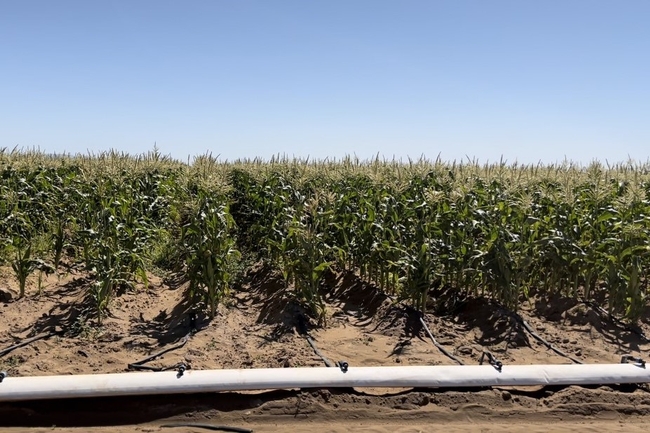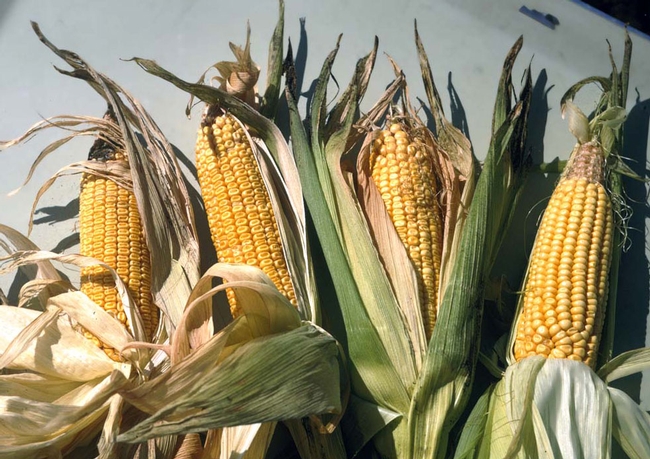Posts Tagged: Corn
Drip-irrigation study sees ‘huge’ reduction in water, fertilizer use for sweet corn
Study by UCCE advisor in Imperial County also shows 5% increase in yield
A new study suggests that drip irrigation for sweet corn can significantly conserve water, reduce fertilizer use and boost crop yield in the low desert of California – and likely in other areas of California with similar conditions.
Although Imperial County is California's top sweet corn-producing county, with about 8,000 acres planted on average each year, irrigation methods for this crop have been rarely studied in this region (or anywhere else in the state), according to Ali Montazar, UC Cooperative Extension irrigation and water management advisor for Imperial, Riverside and San Diego counties.
Montazar conducted a study in the Imperial Valley over two crop seasons, 2020-21 and 2021-22, to demonstrate and quantify the potential benefits of switching to drip irrigation from the more common furrow irrigation method. The study, available in a recent issue of UC Agriculture and Natural Resources' Agricultural Briefs, will be published in a future issue of Vegetables West.
“I'm hoping with this project we can encourage growers to adopt it, because it seems very promising,” said Montazar, noting that drip irrigation is a “new practice” for sweet corn in California.
Among the 11 commercial sweet corn fields in the study over the 2021-22 season, the six that were under drip irrigation used, on average, 37% less water than the five under furrow irrigation. In absolute terms, the drip-irrigated fields saw an average water savings of 2.2 acre-feet per acre; for Montazar, who has studied drip for a variety of crops in the Imperial Valley, that was an astonishing result.
“I've worked with drip on processed onions, lettuce, alfalfa, spinach … we've never seen a figure like 2.2 acre-feet per acre, that's huge,” he said, attributing the dramatic drop-off to the high volume of water required to furrow-irrigate the sandy soil in the Imperial Valley.
More efficient irrigation also means less fertilizer is needed – a boon to the environment and Salton Sea water quality, as well as growers' bottom line. With fertilizer prices continuing to rise, sweet corn growers using drip could see a substantial 25% cost savings on fertilizer expenses – about $150 per acre less – compared to furrow irrigation, according to Montazar's study.
And by relieving plants of the stress from over- and under-irrigated conditions, drip irrigation helps keep soil moisture at its “sweet spot” – resulting in a 5% increase in marketable crop yield for sweet corn in the study.
“When we have a better, more efficient irrigation system, we can maintain soil moisture at a desired level, over time and space,” Montazar explained.
Because the benefits of drip appear to be linked to soil conditions (sandy loam, and other light soils), Montazar believes that this irrigation practice could deliver relatively similar water and fertilizer savings and improved crop yield in other regions across California, regardless of climactic differences.
“If you use drip in any part of the state, you have the benefits of drip – more uniform water application, more uniform fertilizer – that's not related to the desert,” he said. “That's part of the system's potential.”
Montazar plans to follow up on his preliminary study with additional research on sweet corn and drip irrigation during the 2022-23 crop season.
UC studies estimate cost of production for six crops
Six new studies outlining the cost of production and estimated revenue for orchard and field crops have been released by UC Agriculture and Natural Resources. The crops include lemons and oranges, field corn, paddy rice, silage corn and strawberries.
Each analysis is based upon a hypothetical farm operation using practices common to the region. Input and reviews were provided by growers, UC Cooperative Extension farm advisors and other agricultural associates. The authors describe the assumptions used to identify current costs for individual crops, material inputs and cash and non-cash overhead. A ranging analysis table shows profits over a range of prices and yields. Other tables show the monthly cash costs, the costs and returns per acre, hourly equipment costs, and the whole farm annual equipment, investment and business overhead costs.
The studies for establishing orchards to produce lemons and oranges estimate costs for growing in Kern and Tulare counties. Revenue for the citrus is based on estimated sales to the fresh packaging market.
The study for organic strawberries takes into consideration growing conditions on the Central Coast of California and complying with the National Organic Program. In particular, it focuses on growing organic strawberries in Santa Cruz and San Benito counties for the fresh packaging market.
The study for producing paddy rice in the Sacramento Valley focuses on the costs of growing medium-grain rice, under a rice-only rotation in Butte, Colusa, Glenn and Yolo counties.
The field corn study focuses on the production costs of a full-season corn crop in the Sacramento Valley and the northern San Joaquin Valley. This region would include Colusa, Glenn, Sacramento, Sutter and Yolo counties. The study based costs on a farm using furrow irrigation and Roundup Ready-GMO seed.
The study on silage corn, double cropped under conservation tillage methods, focuses on production costs of corn silage using minimum tillage operations in the northern San Joaquin Valley. The corn is planted in the spring after a winter forage crop is harvested. The study is based its costs on a farm using border/flood irrigation and Roundup Ready-GMO seed.
These new study titles are
- “Sample Costs to Establish an Orchard and Produce Lemons in the San Joaquin Valley-South-2015”
- “Sample Costs to Establish an Orchard and Produce Oranges in the San Joaquin Valley-South-2015”
- “Sample Costs to Produce Organic Strawberries in the Central Coast Region-2014”
- “Sample Costs to Produce Rice in the Sacramento Valley-2015”
- “Sample Costs to Produce Field Corn in the Sacramento Valley and Northern San Joaquin Valley-2015”
- “Sample Costs to Produce Silage Corn-Conservation Tillage Practices in the Northern San Joaquin Valley-2015”
These cost-of-production studies can be downloaded for free from the UC Davis Department of Agriculture and Resource Economics website http://coststudies.ucdavis.edu. Sample costs are also available for many other commodities. Many earlier production cost studies for agricultural commodities are also available at http://coststudies.ucdavis.edu/archived.php.
For additional information or an explanation of the calculations used in the studies, contact Don Stewart, staff research associate in the Department of Agriculture and Resource Economics at UC Davis at (530) 752-4651, destewart@ucdavis.edu.
'More crop per drop' drought strategy touted
Corn silage producers can get 'more crop per drop" with deficit irrigation, however productivity will decline, reported Dennis Pollock in Western Farm Press. Pollack based the story on a seminar at the World Ag Expo earlier this month presented by Mark Lundy, UC Agriculture and Natural Resources Cooperative Extension advisor for Colusa, Sutter and Yuba counties.
Lundy said there are certain times in the crop's development that farmers will not want to stress the corn silage - when tassels and silk are forming. At other times in its development, even if the corn is stressed, the application of more water does not bring a proportionate increase in yield.
The UC ANR advisor suggested farmers choose planting dates, varieties and cultural practices that will maximize irrigation efficiency.
“Look at what you choose to grow and perhaps plant later with a short variety or drought tolerant variety,” he said. “And get weeds under control. They take up water.”
New UC studies examine cost of producing beef, alfalfa hay, corn silage, rice, prunes, raspberries and avocados
New studies showing production costs for beef, alfalfa hay, corn silage, rice, prunes (dried plums), raspberries and avocados (conventional and organic) are now available from the University of California Cooperative Extension.
Each analysis is based upon hypothetical farm operations using practices common in the region. Input and reviews were provided by farm advisors, researchers, growers, farm accountants, pest control advisers, consultants and other agricultural associates.
Assumptions used to identify current costs for the individual crops, material inputs, cash and non-cash overhead are described. A ranging analysis table shows profits over a range of prices and yields. Other tables show the monthly cash costs, the costs and returns per acre, hourly equipment costs, and the whole farm annual equipment, investment, and business overhead costs.
The new studies are:
Sample Costs for Finishing Beef Cattle on Grass, 2012, Sacramento Valley, by Larry C. Forero, Roger S. Ingram, Glenn A. Nader, Karen M. Klonsky, and Richard L. De Moura.
Sample Costs to Produce Corn Silage, 2012, San Joaquin Valley by Carol A. Frate, Brian H. Marsh, Karen M. Klonsky, and Richard L. De Moura.
Sample Costs to Produce Rice, 2012, Sacramento Valley by Christopher A. Greer, Randall G. Mutters, Luis A. Espino, Paul Buttner, Karen M. Klonsky, Richard L. De Moura and Kabir P. Tumber.
Sample Costs to Establish a Prune Orchard and Produce Prunes, 2012, Sacramento Valley by Richard P. Buchner, Joseph H. Connell, Franz J. Niederholzer, Carolyn J. DeBuse, Karen M. Klonsky, and Richard L. De Moura.
Sample Costs to Produce Fresh Market Raspberries, 2012, Central Coast by Mark Bolda, Laura Tourte, Karen M. Klonsky, and Richard L. De Moura.
Avocado Sample Establishment and Production Costs and Profitability Analysis for Ventura, Santa Barbara and San Luis Obispo Counties, 2011, Conventional Production Practices and Avocado Sample Establishment and Production Costs and Profitability Analysis for San Diego and Riverside Counties, 2011. Conventional Production Practices by Etaferahu Takele, Gary Bender and Mao Vue.
Avocado Sample Establishment and Production Costs and Profitability Analysis for Ventura, Santa Barbara and San Luis Obispo Counties, 2011, Organic Production Practices and Avocado Sample Establishment and Production Costs and Profitability Analysis for San Diego and Riverside Counties, 2011, Organic Production Practices by Etaferahu Takele, Gary Bender and Mao Vue.
All cost of production studies are available online at http://coststudies.ucdavis.edu, at UC Cooperative Extension offices or by calling (530) 752-3589. For additional information on the studies, contact Richard De Moura at rdemoura@ucdavis.edu in the UC Davis Department of Agricultural and Resource Economics.
Corn smut for dinner tonight...yum!
I often look at foods and wonder, “Who’s idea was it to eat this?” Some foods just don’t look like they should be food, including huitlacoche.
Huitlacoche is corn smut — a fungus that often infects sweet corn during times of drought. It enters the plant through the ovaries, and replaces the corn kernels with large tumor-like spores that look like really ugly mushrooms. Farmers in the U.S. have spent millions of dollars trying to eradicate the infection. The UC Davis Student Farm has a bad case of corn smut this year, and it’s threatening to ruin their entire crop.
But it may not be such a bad thing. Often known as the Mexican truffle, huitlacoche is considered a delicacy in Mexico. In fact, the Aztecs used to purposely scratch their corn plant with a knife to encourage the growth of huitlacoche.
According to this article in the Huffington Post, huitlacoche may actually be more nutritious than the corn it infected. It’s full of protein, minerals, and other nutritious compounds that don’t always exist in the corn itself. It’s also more valuable than the corn itself — in a study conducted by University of Wisconsin, an ear of huitlacoche sold for approximately $1.20 and cost about 41 cents to produce. An ear of corn without the infection cost less than 10 cents to produce, but sold for only a few cents more.
Although it sells for approximately $20 per pound in Napa Valley, few American growers have converted to growing the fungus. Most American growers lack the resources needed for inoculation, and huitlacoche is highly perishable; however, demand is slowly increasing and several American growers have started growing the specialized crop.
Huitlacoche is typically found in tacos, quesadillas, tamales, and other traditional Mexican cuisine. In the U.S., it’s mostly found canned in Mexican grocery stores, and can occasionally be found in high-end restaurants or traditional Mexican restaurants. Want to give it a try? For suggestions of restaurants that serve the delicacy in the San Francisco Bay Area, read this blog at chowhound.com. Or if you’re really brave and want to cook it yourself, try including it as a side dish or making huitlacoche soup.
I was out at the UC Davis Student Farm this weekend looking for huitlacoche, and sure enough, about one in every 10 ears of corn had it. Though it could be profitable, the student farm has no intention of selling it this time around.
“We just don’t have the resources to harvest it, and we don’t have the market here to make it profitable” said Edwina King, the Market Garden Coordinator at the UCD Student Farm.
But that won’t stop some locals from getting excited about the crop. Jessica Myles, a UC Davis graduate student who helped me identify the fungus at the student farm, harvested some herself.
“I’m going to go home and cook it up and freeze it, I’m so excited!”
She’s promised to make me huitlacoche tamales. As curious as I am about trying it, I may have to close my eyes while I eat it. Stay tuned.









